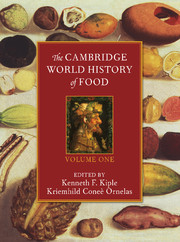Book contents
- Frontmatter
- Introduction
- Part I Determining What Our Ancestors Ate
- Part II Staple Foods: Domesticated Plants and Animals
- II.A Grains
- II.B Roots, Tubers, and Other Starchy Staples
- II.C Important Vegetable Supplements
- II.D Staple Nuts
- II.E Animal, Marine, and Vegetable Oils
- II.F Trading in Tastes
- II.G Important Foods from Animal Sources
- II.G.1 American Bison
- II.G.2 Aquatic Animals
- II.G.3 Camels
- II.G.4 Caribou and Reindeer
- II.G.5 Cattle
- II.G.6 Chickens
- II.G.7 Chicken Eggs
- II.G.8 Dogs
- II.G.9 Ducks
- II.G.10 Game
- II.G.11 Geese
- II.G.12 Goats
- II.G.13 Hogs (Pigs)
- II.G.14 Horses
- II.G.15 Insects
- II.G.16 Llamas and Alpacas
- II.G.17 Muscovy Ducks
- II.G.18 Pigeons
- II.G.19 Rabbits
- II.G.20 Sea Turtles and Their Eggs
- II.G.21 Sheep
- II.G.22 Turkeys
- II.G.23 Water Buffalo
- II.G.24 Yak
- Part III Dietary Liquids
- Part IV The Nutrients – Deficiencies, Surfeits, and Food-Related Disorders
- References
II.G.6 - Chickens
from II.G - Important Foods from Animal Sources
Published online by Cambridge University Press: 28 March 2008
- Frontmatter
- Introduction
- Part I Determining What Our Ancestors Ate
- Part II Staple Foods: Domesticated Plants and Animals
- II.A Grains
- II.B Roots, Tubers, and Other Starchy Staples
- II.C Important Vegetable Supplements
- II.D Staple Nuts
- II.E Animal, Marine, and Vegetable Oils
- II.F Trading in Tastes
- II.G Important Foods from Animal Sources
- II.G.1 American Bison
- II.G.2 Aquatic Animals
- II.G.3 Camels
- II.G.4 Caribou and Reindeer
- II.G.5 Cattle
- II.G.6 Chickens
- II.G.7 Chicken Eggs
- II.G.8 Dogs
- II.G.9 Ducks
- II.G.10 Game
- II.G.11 Geese
- II.G.12 Goats
- II.G.13 Hogs (Pigs)
- II.G.14 Horses
- II.G.15 Insects
- II.G.16 Llamas and Alpacas
- II.G.17 Muscovy Ducks
- II.G.18 Pigeons
- II.G.19 Rabbits
- II.G.20 Sea Turtles and Their Eggs
- II.G.21 Sheep
- II.G.22 Turkeys
- II.G.23 Water Buffalo
- II.G.24 Yak
- Part III Dietary Liquids
- Part IV The Nutrients – Deficiencies, Surfeits, and Food-Related Disorders
- References
Summary
Origins
The chicken (Gallus gallus or Gallus domesticus) is generally considered to have evolved from the jungle fowl (G. gallus), which ranges throughout the area between eastern India and Java. Within the nomenclature, G. domesticus is normally used by scholars who believe in a polyphyletic origin for the domestic chicken (from G. gallus, Gallus sonnerati, and Gallus lafayettei), whereas G. gallus is used by those who support a unique origin from the various subspecies of wild G. gallus. Debates regarding the origin and spread of the domestic chicken focus both on its genetic basis and the “hearth area” of its initial domestication.
The osteological identification of domestic chickens has been made both on a contextual basis (i.e., the occurrence of Gallus bones outside of the birds' normal wild range) and on osteometric grounds (i.e., the occurrence of bones that are larger than those of modern wild jungle fowl and therefore would seem to be the result of selective breeding). Recent research of this nature has resulted in a radical revision of the standard view of the domestication of the chicken. The presence of domestic fowl bones in third-millennium-B.C. archaeological excavation contexts at Harappa and Mohenjo-Daro in Pakistan led earlier writers (Zeuner 1963; Crawford 1984) to assume that the chicken was first domesticated in this area. However, in 1988, B. West and B.-X. Zhou presented archaeological data showing domestic chickens to be present at China’s Yangshao and Peiligan Neolithic sites, which dated from circa 6000 to 4000 B.C. As a consequence, because wild forms of Gallus are entirely absent in China, and as the climate would have been inimical to them in the early Holocene, it seems likely that chickens were domesticated elsewhere at an even earlier date. In the absence of evidence from India, Southeast Asia (i.e., Thailand) has been put forward as a likely hearth area (West and Zhou 1988).
- Type
- Chapter
- Information
- The Cambridge World History of Food , pp. 496 - 499Publisher: Cambridge University PressPrint publication year: 2000
References
- 4
- Cited by

